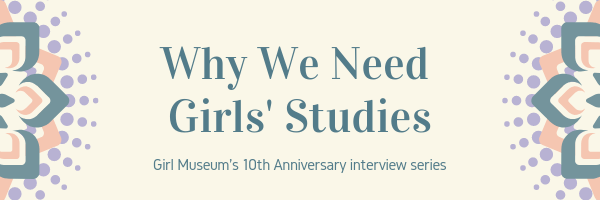
Welcome to Girl Museum’s 10th Anniversary year. We have many exciting projects for our community, including this new blog series, Why We Need Girls’ Studies. Each month we will feature an interview with a scholar in the field to get insights about what we are all doing in this space to further our understanding of girlhood and its experiences.
Our twelfth and final interview is with Dr. Kristine Moruzi, Senior Lecturer in Writing and Literature, at Deakin University.
Let’s begin with defining our terms, especially since Girls’ Studies is a relatively new academic area. Can you tell our readers what your field of expertise is and how you see it within Girls’ Studies?
I have a PhD in English Literature and sometimes call myself a literary historian. At other times I call myself a children’s literature scholar since I focus primarily on girls’ literature in the nineteenth and early twentieth centuries and also on contemporary young adult fiction that often features girls as protagonists.
Why do you think we need Girl Studies?
Children’s literature is a somewhat marginalised field in the broader area of literary studies, yet it has its own set of disciplinary practices that focus on children and childhood and also consider how adult writers, editors, publishers, teachers, parents, and librarians are implicated in the production and selection of texts for young people. Within the field of children’s literature, more scholars are turning their attention to texts written for and aimed at girls, but it has tended to be a relatively under-researched area. Indeed, historical research on texts for girls is relatively scant, yet it was an important way through which girls learned about how they should behave. Moreover, some of these ideas about how girls should behave are still with us today. Studying girls’ literature from the past is an important way to better understand these inheritances.
There are vast disparities globally in girls’ situations, with incremental improvements in some areas and serious steps backwards in others. From your work in Girls’ Studies, what are some positives you take away from the academic interest in girls and girlhood? What changes can it lead to?
One of the most exciting shifts in the field of contemporary children’s literature – and girls’ literature in particular – is the growing attention being paid to diversity and representation. We are seeing more books being published by a wider variety of #OwnVoices authors, which means readers have access to a more diverse array of texts that challenge the hegemony of white, middle-class, heteronormative depictions of girlhood.
What are the biggest challenges now and going forward for Girls Studies in an academic world? Do you see Girls’ Studies programs being a reality?
At my university, we have just re-started a Gender and Sexuality Studies major, which is an exciting development, but I think a focus on girls’ studies specifically is still a long way away. The solution for me as a researcher is to find my networks of other interested scholars through other venues and as a teacher to embed some of this content into my classes.
We have an ongoing research question we ask everyone we interview: Do you think the Internet is a safe place for girls and why?
Oh, this is a tough question! What do we mean by safe? If safe means ‘risk free’, then I don’t think so. But I do think that with proper education, girls can mobilise internet-based technologies to produce a sense of community that may not be available to them in their every-day lives. Plus, girls’ engagement on the internet has the capacity to produce change on issues that are important to them.
To find out more about Dr. Moruzi, click here.
Thank you for reading this series. We hope to have more like it next year.
-Ashley E. Remer
Head Girl
Girl Museum Inc.
